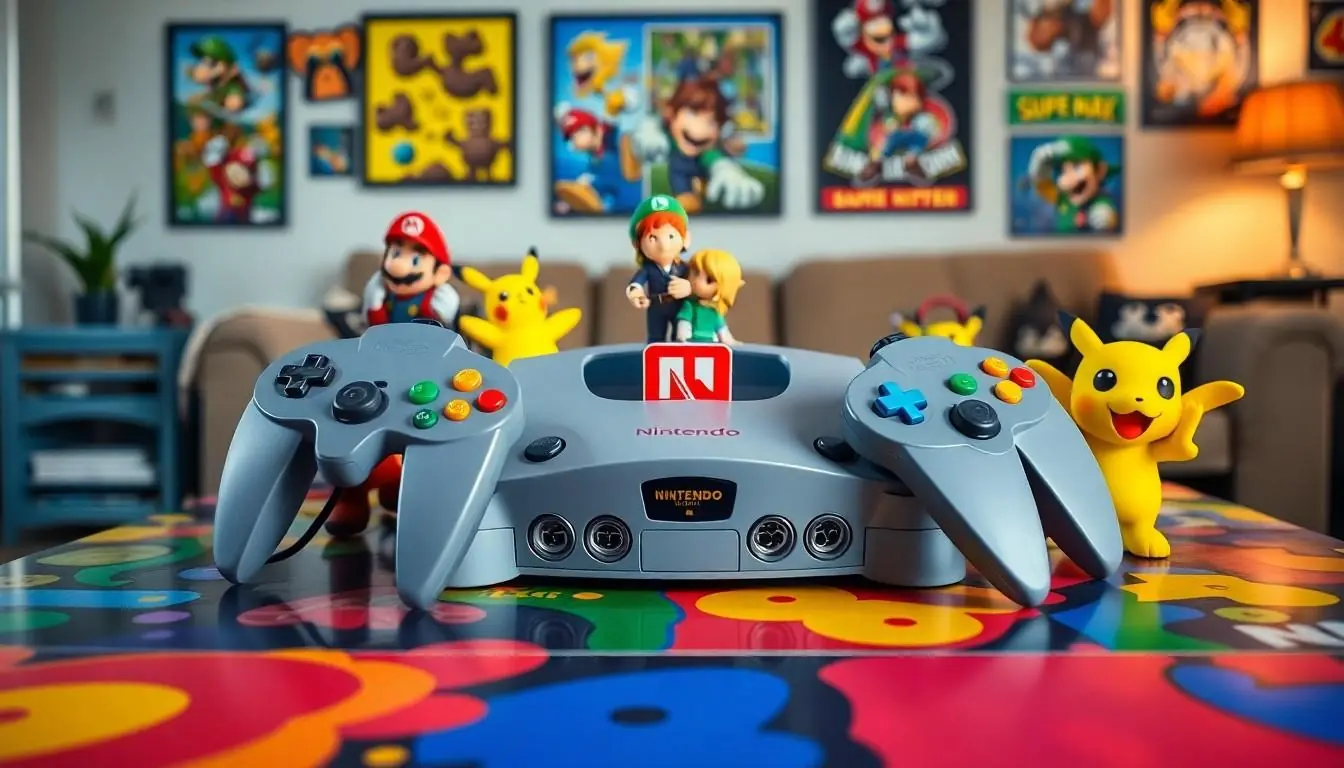In the late ’90s, a revolution in gaming took place, and it came in the form of a quirky little title called Super Smash Bros. on the Nintendo 64. Imagine a chaotic battlefield where beloved characters like Mario, Link, and Pikachu duke it out in a pixelated frenzy. It’s like a family reunion gone rogue, where everyone’s invited, and no one knows how to play nice!
This groundbreaking brawler not only brought friends together but also sparked a competitive spirit that still thrives today. With its easy-to-learn mechanics and endless fun, it’s no wonder that Super Smash Bros. became a staple in living rooms and esports arenas alike. So grab your controller and prepare for some nostalgic mayhem; this isn’t just a game—it’s a legendary showdown that defined a generation.
Table of Contents
ToggleOverview Of Nintendo 64 Smash Bros
Super Smash Bros. debuted on the Nintendo 64 in 1999, marking a groundbreaking moment in gaming history. Players select from a roster of 12 iconic characters, each with unique abilities and moves. The game combines elements of traditional fighting games with platforming mechanics, creating chaotic yet strategic battles.
Characters such as Mario, Link, and Pikachu engage in combat across diverse stages inspired by popular titles, enhancing nostalgia. Developers designed the game to emphasize multiplayer interaction, encouraging local play among friends. The simplicity of the controls allows for a welcoming experience, making it accessible to newcomers while retaining depth for veterans.
Item pickups add another layer of strategy, introducing randomness that influences gameplay. Players can wield various items, from explosive Bomb-ombs to healing capsules. Each match can shift dramatically based on item availability and character dynamics, fostering excitement.
The game features a unique percentage-based health system, differentiating it from traditional health bars. Instead of depleting health, players aim to knock opponents off the stage, adding a dynamic approach to competition. This mechanic encourages players to focus on avoiding attacks while launching their opponents.
Reception was overwhelmingly positive, leading to the game’s status as a classic within the gaming community. Its success spawned multiple sequels and a dedicated esports scene, showcasing the enduring appeal of the franchise. Super Smash Bros. for Nintendo 64 laid the foundation for future titles, cementing its legacy in gaming culture.
Gameplay Mechanics
Super Smash Bros. for the Nintendo 64 features engaging gameplay mechanics that keep players returning for more.
Character Selection
Character selection impacts gameplay significantly. Players choose from a roster of twelve iconic characters, including Mario, Link, and Pikachu. Each character brings uniqueness, ensuring various playstyles. Players often gravitate towards favorites or experiment with different characters to find the best fit for their strategy. Customization in character choice promotes diverse gaming experiences, allowing players to adapt and develop personal techniques. Engaging in multiplayer matches enhances the enjoyment of character selection, as friends compare skills using different characters.
Unique Abilities
Unique abilities define each character and influence competitive play. Mario utilizes fireballs for ranged attacks, while Link employs a combination of sword strikes and bombs for versatility. Pikachu’s quick agility allows rapid movements and electric attacks, creating unpredictability. Understanding these abilities helps players formulate strategies and exploit opponents’ weaknesses. Mastering a character’s unique moveset can lead to mastering timing and combos. Each ability adds depth to the gameplay, enriching the overall experience by encouraging players to explore combinations and tactics.
Game Modes
Game modes diversify the playing experience and cater to various preferences. Players can engage in one-on-one battles, team matches, or free-for-alls. The larger multiplayer matches create chaotic environments, emphasizing the game’s entertaining nature. Time and stock modes offer different winning conditions, influencing strategies employed during battles. Event matches present unique challenges that require adapting gameplay tactics and skills. Unlocking additional characters and stages adds a layer of progression, motivating players to explore all the game modes. Each mode fosters camaraderie while fueling competitive spirit among players.
Graphics And Sound Design
Super Smash Bros. on the Nintendo 64 introduced players to uniquely vibrant graphics and engaging sound design. The graphics feature a colorful aesthetic that complements the whimsical nature of the game.
Visual Style
Visual style employs a cartoonish design, utilizing a bright color palette. Character models showcase distinct features from each franchise, enhancing recognition. Environments reflect various themed stages, drawing inspiration from iconic games. The 3D graphics, while modest by today’s standards, innovated gameplay immersion. Players experience a blend of charming visuals and dynamic animations during frantic brawls. Unique visual effects, like explosions and power-ups, further enliven the action.
Soundtrack
Soundtrack elevates gameplay with memorable tunes and sound effects. Composed of familiar melodies, it incorporates music from iconic franchises, creating nostalgia. Characters express themselves through unique voice clips, enhancing personality. Audio cues signal important gameplay events, adding strategic depth. Engaging sound feedback rewards players for successful hits or knockouts, enhancing satisfaction. The combination of lively music and punchy sound effects contributes to a vibrant gaming atmosphere.
Impact On The Gaming Community
Super Smash Bros. left a significant mark on the gaming community, reshaping perceptions of multiplayer fighting games and paving the way for future titles.
Competitive Scene
The competitive scene for Super Smash Bros. emerged rapidly after its release. Tournaments began sprouting up worldwide, showcasing players’ skills and strategic play. Evo, one of the largest fighting game tournaments, welcomed Super Smash Bros. and solidified its status in competitive gaming. Players developed a dedicated following, specializing in character mastery and tactical approaches. The game’s unique mechanics, like the percentage-based health system, incentivized skillful plays over brute force. As a result, an esports community formed around the game, leading to ongoing events and a vibrant exchange of strategies.
Cultural Influence
Culturally, Super Smash Bros. transcended gaming, becoming part of broader pop culture. Characters from diverse franchises united in a single game, connecting fans across generations. Merchandise, art, and fan communities exploded, reflecting the game’s iconic status. In addition, influential content creators emerged, showcasing gameplay and fostering community engagement. Events and conventions frequently feature Super Smash Bros. tournaments, highlighting the game’s persistent popularity and relevance. The blend of nostalgia and competitive spirit enables ongoing conversations within gaming forums and social media, enriching the gaming community as a whole.
Conclusion
Super Smash Bros. on the Nintendo 64 has left an indelible mark on gaming culture. Its unique blend of iconic characters and engaging gameplay mechanics created a vibrant community that thrives even today. The game not only redefined multiplayer brawlers but also fostered friendships and rivalries among players.
The legacy of Super Smash Bros. continues to influence new titles and inspire competitive gaming. As fans celebrate its rich history through tournaments and online discussions, the game remains a testament to the joy of gaming. Its ability to unite players across generations ensures that it will always hold a special place in the hearts of gamers everywhere.




